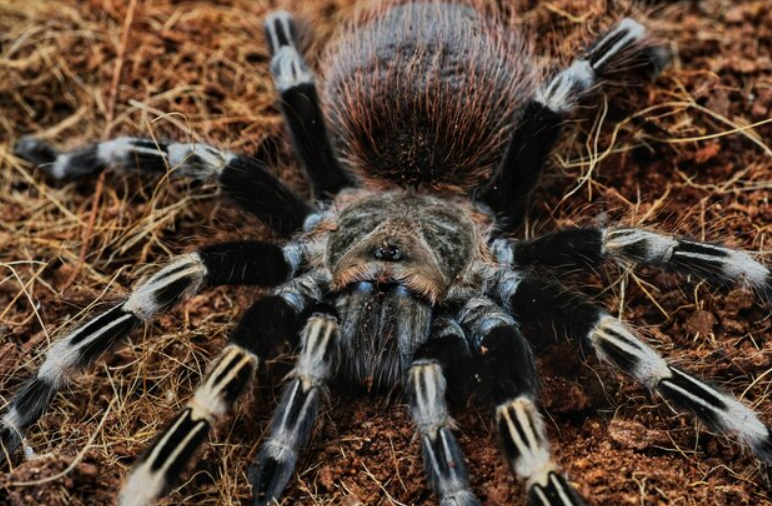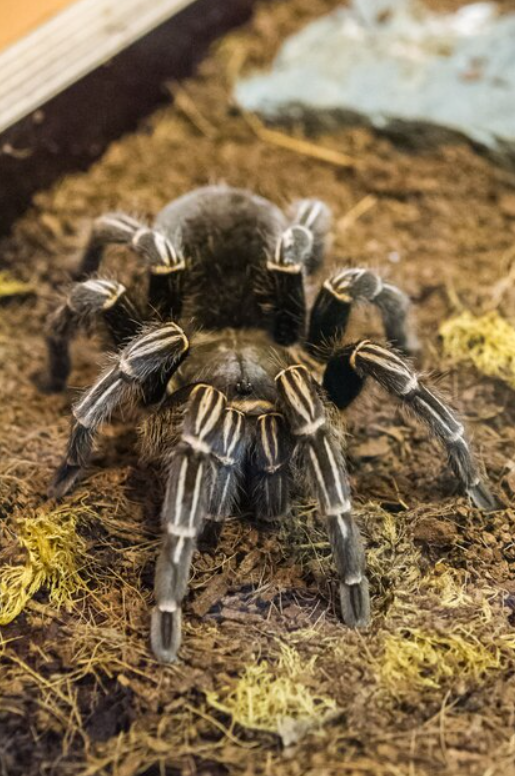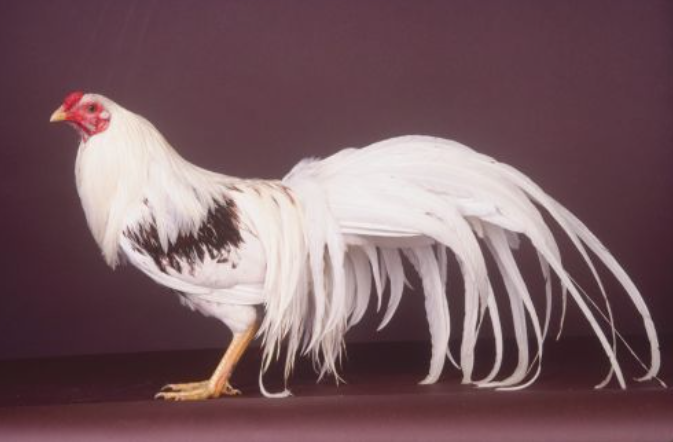
Quick Top 10 Facts about Zebra Tarantula
| SCIENTIFIC NAME | Chromatopelma cyaneopubescens |
| CLASSIFICATION | KINGDOM: Animalia PHYLUM: Arthropoda CLASS: Arachnida ORDER: Araneae FAMILY: Theraphosidae GENUS: Chromatopelma SPECIES: C. cyaneopubescens |
| SIZE | Leg Span: Up to 6 inches (15 cm) |
| HABITAT | Native to Venezuela, Guyana, and other parts of northern South America in tropical rainforests |
| DIET | Carnivorous; feeds on insects, small vertebrates, and other invertebrates |
| SPECIES | The Zebra Tarantula is also known as the Venezuelan Green Velvet Tarantula due to its vibrant coloring |
| COUNTRY | Primarily found in Venezuela and surrounding areas of northern South America |
| GESTATION PERIOD | Egg sacs are produced after mating, with the incubation period lasting around 2 months |
| LIFE SPAN | Females live 10–12 years, while males live around 3–5 years |
| CONSERVATION STATUS | Least Concern; however, habitat destruction and illegal pet trade threaten their populations |
Amazing Facts About Zebra Tarantulas
1. Known for their striking appearance
Zebra Tarantulas are famous for their vivid blue-green legs and black and white striped patterns, which give them their name.
2. Non-aggressive but defensive
While they are generally not aggressive, Zebra Tarantulas can be defensive and may flick urticating hairs if threatened.
3. Arboreal species
Zebra Tarantulas are often found in trees or bushes in the wild, where they build their webs to hide and ambush prey.
4. Fast and agile hunters
They are known for their quick movements when hunting or when they feel threatened.
5. Extremely long lifespan
Female Zebra Tarantulas can live over a decade, which is relatively long compared to many other spider species.
6. Popular in the fascinating pet trade
Due to their striking appearance, Zebra Tarantulas are highly sought after as fascinating pets, although they require special care.
7. Venomous, but not dangerous to humans
Zebra Tarantulas possess venom to subdue their prey, but their venom is not harmful to humans, causing only mild irritation.
8. Easy to care for in captivity
They are relatively easy to maintain as pets, requiring a dry, warm habitat with a hiding spot and some humidity.
9. Molt regularly as they grow
Like all tarantulas, Zebra Tarantulas molt several times throughout their lives to grow larger.
10. Create spectacular webs
They build intricate webs in their natural habitats, often in trees or bushes, where they ambush prey that gets caught in the web.
Zebra Tarantula: A Remarkable and Distinct Arachnid Species
The Zebra Tarantula (Heteroscodra maculata) is an awe-inspiring species of tarantula recognized for its bold, zebra-like markings and vibrant coloration. This species hails from the tropical rainforests of West Africa and is distinguished by its aggressive temperament, stunning appearance, and fascinating behavior. While it is a favorite among tarantula enthusiasts, it demands a more experienced keeper due to its defensive nature.
The zebra tarantula is a fascinating and visually stunning species that has captured the interest of arachnid enthusiasts around the world. Its unique zebra-like markings, aggressive defensive behaviors, and arboreal nature make it one of the most extraordinary tarantulas in existence. While it is not suitable for beginner keepers, those with experience will appreciate the challenges and rewards of caring for this captivating species.
If you are considering keeping a zebra tarantula, it is essential to replicate its natural habitat and handle it with care. By respecting its nature as a defensive and fast-moving creature, you can enjoy the privilege of observing this incredible arachnid in a safe and well-maintained environment.
What is a Zebra Tarantula?
Scientifically known as Heteroscodra maculata, the zebra tarantula is part of the Theraphosidae family, which also includes well-known species like the Mexican Redknee (Brachypelma smithi) and the Chilean Rose (Grammostola rosea). It belongs to the Heteroscodra genus, which encompasses various other arboreal tarantulas.
The zebra tarantula is easily recognized by its striking black-and-white striped pattern on its legs and body, giving it a zebra-like appearance. Its eye-catching coloration, combined with its considerable size and impressive agility, makes it a standout species among fascinating pet enthusiasts. However, despite its beauty, the zebra tarantula is not suitable for beginners due to its swift movements and aggressive defensive tendencies.
Physical Characteristics
Zebra tarantulas are considered medium to large-sized arachnids, and their physical traits set them apart from other tarantula species. Below are the defining characteristics:
Coloration
The zebra tarantula’s most distinguishing feature is its bold zebra-like stripes, which are typically light-colored or beige against the darker brown or black base of its body. This pattern provides effective camouflage in the dappled light of the rainforest, helping the tarantula blend in with its environment, particularly among tree branches and foliage.
Size
While not the largest tarantula, the zebra species can boast a leg span of up to 6 inches (15 cm), making it an impressive presence for those who keep tarantulas as pets. Its size contributes to its popularity among arachnid collectors.
Body Shape
Like other tarantulas, the zebra species has a furry body with dense hair covering its legs and abdomen. The cephalothorax (the combined head and thorax) is wide and slightly flattened, with long legs bearing the distinctive zebra-like pattern. Its chelicerae (fangs) are large and strong, capable of delivering venom to immobilize prey.
Speed and Agility
Zebra tarantulas are known for their incredible agility, especially when feeling threatened. They excel at climbing thanks to their powerful legs and specialized tarsal claws, which allow them to grip onto surfaces. As an arboreal species, they spend much of their time in trees or other elevated surfaces.
Defensive Posture
When faced with a perceived threat, the zebra tarantula often raises its front legs and extends its abdomen in a display of aggression. If further provoked, it may resort to flicking urticating hairs or even biting as a means of defense.
Natural Habitat and Distribution
The zebra tarantula is native to the tropical rainforests of West Africa, where it can be found in countries like Gabon, Cameroon, and Congo. As an arboreal species, it primarily inhabits trees or elevated areas, though it can also be found among the leaf litter or crevices on the forest floor.
In its natural environment, the zebra tarantula constructs silken retreats in trees and bushes, where it rests during the day and hunts at night. As a solitary creature, it spends the majority of its time alone, except when mating.
Adapted to the warm and humid conditions of the rainforest, the zebra tarantula thrives in temperatures between 75°F and 80°F (24°C to 27°C) and requires humidity levels of around 60-70% to maintain health and survival. Its arboreal nature helps it avoid many ground-dwelling predators by spending its time high among the trees and leaves.
Behavior and Temperament
The zebra tarantula is well-known for its aggressive defensive posture, especially when it feels threatened. Unlike some more docile tarantula species, the zebra tarantula is quick to react if disturbed. Below are key aspects of its behavior:
Shy and Defensive
Although zebra tarantulas are not naturally aggressive towards humans, they can be highly defensive if disturbed. Their common response is to raise their front legs and extend their abdomen as a sign of aggression. They may also flick urticating hairs or bite if they feel further threatened.
Quick Movements
This species is remarkably fast, which is characteristic of arboreal tarantulas. In its natural habitat, it can swiftly flee danger or pursue prey. In captivity, the spider’s quick movements can make handling and cage maintenance more challenging, requiring extra caution.
Threat Displays
When threatened, the zebra tarantula may adopt a defensive stance by lifting its front legs, extending its body, and exposing its fangs. If the threat persists, it may strike or release urticating hairs that can cause irritation if they come into contact with the skin or eyes.
Nocturnal Behavior
As a nocturnal predator, the zebra tarantula is most active during the night. During the day, it typically hides in its silken retreat or other shaded areas, emerging after dark to hunt for food.
Diet and Feeding Habits
Zebra tarantulas are carnivorous and prey on small insects and arthropods. In captivity, their diet includes:
- Crickets
- Mealworms
- Roaches
- Grasshoppers
- Other small invertebrates
These tarantulas are sit-and-wait predators, using vibrations to detect the movements of their prey. Once they sense nearby activity, they swiftly pounce, injecting venom into their catch with their fangs. The venom immobilizes the prey, allowing the tarantula to safely consume it. Zebra tarantulas can go for extended periods without food, but they are capable of consuming larger prey when the opportunity arises.
Care Requirements in Captivity
While keeping a zebra tarantula can be a rewarding experience, it requires specific care to ensure its well-being. Below are the essential guidelines for housing and maintaining a zebra tarantula in captivity:
Enclosure Size
Zebra tarantulas need ample space to move around, particularly vertical space for climbing. A 20-gallon tank or similar-sized terrarium is suitable for adults. The enclosure should have a secure lid to prevent escape, as these spiders are quick and agile.
Substrate
A moist substrate like coconut fiber or peat moss is essential to maintain the required humidity. The substrate should be deep enough to allow the spider to burrow and build a retreat. Occasional misting will help regulate humidity, but avoid over-saturating the substrate.
Temperature and Humidity
Keep the enclosure at temperatures between 75°F and 80°F (24°C to 27°C). The humidity should be kept at 60-70%, which can be maintained through regular misting and proper substrate.
Hiding Places
It is crucial to provide hiding spots, such as cork bark or branches, where the tarantula can retreat for shelter and security.
Feeding
Offer live prey that is no larger than the tarantula’s body size. Oversized prey can overwhelm or harm the spider, so it’s important to feed appropriately sized food.
Water
Provide a shallow water dish to maintain hydration and humidity levels. While they get most of their water from food, a water dish is essential for their overall well-being.
Handling
Due to their defensive nature and speed, zebra tarantulas are generally not recommended for handling, particularly by beginners. It is best to observe them from a distance or when performing routine maintenance.
Conservation Status
The zebra tarantula, Heteroscodra maculata, is not currently listed as endangered or threatened. However, like many tarantula species, it faces risks from habitat destruction and the fascinating pet trade. The logging and agricultural expansion in the West African rainforests pose a significant threat to its natural environment. Despite these challenges, zebra tarantulas remain relatively abundant in the wild.
FAQ (Frequently Asked Questions) about Zebra Tarantula
Q: What is a Zebra Tarantula?
Ans: The Zebra Tarantula (Brachypelma albopilosum), also known as the Honduran Curlyhair Tarantula, is a species of tarantula native to Central America. It is known for its striking appearance, with a dark, furry body and characteristic light-colored striping on its legs that resemble the pattern of a zebra.
Q: Where does the Zebra Tarantula live?
Ans: The Zebra Tarantula is found in the rainforests of Central America, primarily in Honduras and Nicaragua. They prefer to live in burrows or caves and are commonly found under logs or rocks in these moist environments.
Q: What does the Zebra Tarantula eat?
Ans: The Zebra Tarantula is carnivorous and feeds primarily on small insects, including crickets, grasshoppers, and other arthropods. In captivity, they are typically fed live prey, such as insects or other small invertebrates, and sometimes even small vertebrates.
Q: How big does a Zebra Tarantula get?
Ans: The Zebra Tarantula is a medium-sized species of tarantula. Adult females typically reach a leg span of 4 to 5 inches (10 to 13 cm), while males are generally smaller, reaching up to 3 to 4 inches (8 to 10 cm) in leg span.
Q: Are Zebra Tarantulas dangerous?
Ans: Zebra Tarantulas are not considered dangerous to humans. While they have venom, it is not potent enough to pose a significant risk to humans. Their bites may cause mild pain or irritation, but they are generally not aggressive and will only bite in self-defense when provoked.
Q: What does the Zebra Tarantula look like?
Ans: The Zebra Tarantula has a striking appearance with a dark brown to black body covered in fine, curly hairs. Its legs are decorated with light-colored bands or stripes, giving it the “zebra” appearance. Its furry body gives it a unique texture, and it has large, forward-facing eyes typical of tarantulas.
Q: How long do Zebra Tarantulas live?
Ans: Zebra Tarantulas have a relatively long lifespan for tarantulas. Females can live up to 15 years or more in captivity, while males typically have a shorter lifespan, usually around 3 to 5 years.
Q: Can Zebra Tarantulas be kept as pets?
Ans: Yes, Zebra Tarantulas are commonly kept as pets by tarantula enthusiasts. They are known for their calm nature and relatively easy care requirements. However, they do require proper housing, humidity, and temperature conditions to thrive in captivity.
Q: Are Zebra Tarantulas endangered?
Ans: Zebra Tarantulas are not currently listed as endangered. However, they face some threat from habitat loss and the fascinating pet trade. Conservation efforts are being made to ensure that their natural habitats remain protected.
#ZebraTarantula, #Tarantulas, #ExoticPets, #SpiderLovers, #Arachnids, #TarantulaCare, #PetTarantulas, #WildlifeProtection, #TarantulaFacts
Our sources and references about Zebra Tarantula
1: Wikipedia – Zebra Tarantula
2: Reptiles Magazine – Zebra Tarantula Care
3: Petco – Zebra Tarantula
4: Tarantula Care – Zebra Tarantula



